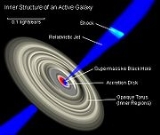
Relativistic jet
Encyclopedia
- The lower-energy non-relativisticRelativistic particleA relativistic particle is a particle which moves with a relativistic speed; that is, a speed comparable to the speed of light. This is achieved by photons to the extent that effects described by special relativity are able to describe those of such particles themselves...
version of this phenomenon is described at polar jetPolar jetA polar jet is a phenomenon often seen in astronomy, where streams of matter are emitted along the axis of rotation of a compact object. It is usually caused by the dynamic interactions within an accretion disc. When matter is emitted at speeds approaching the speed of light, these jets are called...
.

Active galactic nucleus
An active galactic nucleus is a compact region at the centre of a galaxy that has a much higher than normal luminosity over at least some portion, and possibly all, of the electromagnetic spectrum. Such excess emission has been observed in the radio, infrared, optical, ultra-violet, X-ray and...
, notably radio galaxies
Radio galaxy
Radio galaxies and their relatives, radio-loud quasars and blazars, are types of active galaxy that are very luminous at radio wavelengths, with luminosities up to 1039 W between 10 MHz and 100 GHz. The radio emission is due to the synchrotron process...
and quasar
Quasar
A quasi-stellar radio source is a very energetic and distant active galactic nucleus. Quasars are extremely luminous and were first identified as being high redshift sources of electromagnetic energy, including radio waves and visible light, that were point-like, similar to stars, rather than...
s. Their lengths can reach several thousand or even hundreds of thousands of light years. The hypothesis is that the twisting of magnetic fields in the accretion disk collimates
Collimated light
Collimated light is light whose rays are parallel, and therefore will spread slowly as it propagates. The word is related to "collinear" and implies light that does not disperse with distance , or that will disperse minimally...
the outflow along the rotation axis of the central object, so that when conditions are suitable, a jet will emerge from each face of the accretion disk. If the jet is oriented along the line of sight to Earth, relativistic beaming
Relativistic beaming
Relativistic beaming is the process by which relativistic effects modify the apparent luminosity of emitting matter that is moving at speeds close to the speed of light...
will change its apparent brightness. The mechanics behind both the creation of the jets and the composition of the jets are still a matter of much debate in the scientific community; it is hypothesized that the jets are composed of an electrically neutral mixture of electron
Electron
The electron is a subatomic particle with a negative elementary electric charge. It has no known components or substructure; in other words, it is generally thought to be an elementary particle. An electron has a mass that is approximately 1/1836 that of the proton...
s, positron
Positron
The positron or antielectron is the antiparticle or the antimatter counterpart of the electron. The positron has an electric charge of +1e, a spin of ½, and has the same mass as an electron...
s, and proton
Proton
The proton is a subatomic particle with the symbol or and a positive electric charge of 1 elementary charge. One or more protons are present in the nucleus of each atom, along with neutrons. The number of protons in each atom is its atomic number....
s in some proportion.

Stellar black hole
A stellar black hole is a black hole formed by the gravitational collapse of a massive star. They have masses ranging from about 3 to several tens of solar masses...
s. These systems are often called microquasars. A famous example is SS433, whose well-observed jet has a velocity of 0.23c
Speed of light
The speed of light in vacuum, usually denoted by c, is a physical constant important in many areas of physics. Its value is 299,792,458 metres per second, a figure that is exact since the length of the metre is defined from this constant and the international standard for time...
, although other microquasars appear to have much higher (but less well measured) jet velocities. Even weaker and less-relativistic jets may be associated with many binary systems; the acceleration mechanism for these jets may be similar to the magnetic reconnection
Magnetic reconnection
Magnetic reconnection is a physical process in highly conducting plasmas in which the magnetic topology is rearranged and magnetic energy is converted to kinetic energy, thermal energy, and particle acceleration...
processes observed in the Earth's magnetosphere
Magnetosphere
A magnetosphere is formed when a stream of charged particles, such as the solar wind, interacts with and is deflected by the intrinsic magnetic field of a planet or similar body. Earth is surrounded by a magnetosphere, as are the other planets with intrinsic magnetic fields: Mercury, Jupiter,...
and the solar wind
Solar wind
The solar wind is a stream of charged particles ejected from the upper atmosphere of the Sun. It mostly consists of electrons and protons with energies usually between 1.5 and 10 keV. The stream of particles varies in temperature and speed over time...
.
The general hypothesis among astrophysicists is that the formation of relativistic jets is the key to explaining the production of gamma-ray bursts. These jets have Lorentz factor
Lorentz factor
The Lorentz factor or Lorentz term appears in several equations in special relativity, including time dilation, length contraction, and the relativistic mass formula. Because of its ubiquity, physicists generally represent it with the shorthand symbol γ . It gets its name from its earlier...
s of ~100 (that is, speeds of roughly 0.99995c
Speed of light
The speed of light in vacuum, usually denoted by c, is a physical constant important in many areas of physics. Its value is 299,792,458 metres per second, a figure that is exact since the length of the metre is defined from this constant and the international standard for time...
), making them one of the swiftest celestial objects currently known.
Rotating black hole as energy source
Because of the enormous amount of energy needed to launch a relativistic jet, some jets are thought to be powered by spinning black holeBlack hole
A black hole is a region of spacetime from which nothing, not even light, can escape. The theory of general relativity predicts that a sufficiently compact mass will deform spacetime to form a black hole. Around a black hole there is a mathematically defined surface called an event horizon that...
s. There are two competing theories for how the energy is transferred from the black hole to the jet.
- BlandfordRoger BlandfordRoger David Blandford FRS is an astronomer and astrophysicist. He is a Fellow of the Royal Society and Fellow of the American Academy of Arts and Sciences...
-Znajek process. This is the most popular theory for the extraction of energy from the central black hole. The magnetic fields around the accretion disk are dragged by the spin of the black hole. The relativistic material is possibly launched by the tightening of the field lines. - Penrose mechanismPenrose processThe Penrose process is a process theorised by Roger Penrose wherein energy can be extracted from a rotating black hole...
. This extracts energy from a rotating black hole by frame dragging. This theory was later proven to be able to extract relativistic particle energy and momentum, and subsequently shown to be a possible mechanism for the formation of jets.
See also
- Bipolar outflowBipolar outflowA bipolar outflow represents two continuous flows of gas from the poles of a star. Bipolar outflows may be associated with protostars , or with evolved post-AGB stars ....
- Polar jetPolar jetA polar jet is a phenomenon often seen in astronomy, where streams of matter are emitted along the axis of rotation of a compact object. It is usually caused by the dynamic interactions within an accretion disc. When matter is emitted at speeds approaching the speed of light, these jets are called...
- Blandford-Znajek processBlandford-Znajek processThe Blandford–Znajek process is a mechanism for the extraction of energy from a rotating black hole, discovered by Roger Blandford and Roman Znajek in 1977. It is one of the best explanations for the way quasars are powered. It requires an accretion disc with a strong polar magnetic field around a...
- List of plasma (physics) applications articles
Further reading
- Melia, FulvioFulvio MeliaFulvio Melia is an Italian-American astrophysicist and author. He is Professor of Physics and Astronomy at the University of Arizona and Associate Editor of the Astrophysical Journal Letters...
, The Edge of Infinity. Supermassive Black Holes in the Universe 2003, Cambridge University PressCambridge University PressCambridge University Press is the publishing business of the University of Cambridge. Granted letters patent by Henry VIII in 1534, it is the world's oldest publishing house, and the second largest university press in the world...
, ISBN 978-0-521-81405-8 (Cloth)

